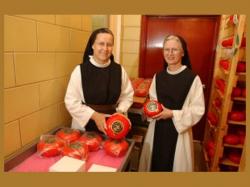Virginia's Cheesemaking Nuns Keep Their Gouda In The Red (Wax)
July 9, 2012 | 2 min to read

It is 10:05 a.m., and Sister Barbara Smickel is shoulder-deep in curds and whey. She is in the cheese barn at Our Lady of the Angels Monastery in Crozet, Va., located about 14 miles west of Charlottesville and down a winding gravel lane. The monastery is a plain yet well-kept brick building perched atop a grassy hillside. The red-and-white cheese barn sits just down the hill; rolling pastures of farmland visible from its small windows.
Amid the roar of a high-pressure hose, which is in use by another sister to clean a piece of equipment nearby, Sister Barbara’s movements are quiet and self-contained. It is a ritualistic habit born from more than two decades of experience and 619 (and counting) batches of Gouda, a cow’s-milk cheese made by cooking cultured milk until the whey separates from the curd. After cooking, the curds are “washed” by draining off some of the whey, then cut, pressed into wheels to expel moisture, and floated in a salty water bath overnight. This process is what defines Gouda, with its characteristic creamy texture and mild, sweet flavor.
Sister Barbara, 75, wears a blue hairnet, a smock printed with sunflowers and knee-high rubber boots. Her feet slosh quietly along the wet concrete floor and alongside a large stainless steel vat holding 725 gallons of curds and whey. She runs her hands through the warm and milky cottage cheeselike mixture. This moment, she tells me, when her sinewy arms search by feel alone for large clumps of curd to break apart, has become her favorite part of making cheese.
“It is very prayerful,” she says. “Like a communion with the Lord and what is becoming cheese under my fingers.”
To read the rest of the story, please go to: Washington Post
